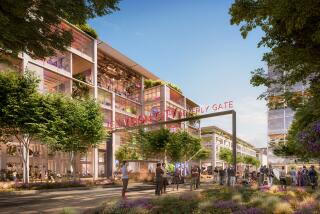Fullerton Residents Win Delay on Road Extension, Subdivision
- Share via
More than 150 Fullerton residents, worried that their neighborhood will be turned into a speedway for rush-hour commuters, won the first round in their battle to stop the extension of Placentia Avenue north of their homes.
For more than two hours Tuesday night, homeowners near Placentia Avenue and Rolling Hills Drive urged the Fullerton City Council to reject the proposed road extension and a new subdivision it would serve.
At issue are plans to extend Placentia Avenue north to Imperial Highway and to establish a 111-home subdivision on 31 acres near the southwest corner of the Imperial Golf Course. Residents want the council to reject the subdivision or at least reduce its density.
City planners recommended that the council approve the road and Unocal Land & Development Co.’s subdivision, which were approved by the Planning Commission last month.
But Dennis Chapman, a regional property manager with Unocal, asked the council to delay its decision until the company can bring in experts to address the residents’ concerns. The council said it would discuss the project again at its Oct. 17 meeting.
John McNaughton, 47, a local resident who is helping to spearhead the opposition, said residents compiled technical data and pored over the project’s environmental-impact report to fight the road extension.
“Typically, people appealing decisions who are just whining about it don’t get far,” he said.
Nineteen residents spoke against Unocal’s proposal, assailing the company’s study of environmental, traffic and noise effects as faulty.
David Henderson, 36, said he spent a weekend preparing his two-page statement arguing that building homes on top of Unocal’s abandoned oil wells could be hazardous.
“I’ve never done anything like this before,” he said. “I had never even heard of an EIR (environmental-impact report).”
Henderson said he doesn’t want Placentia Avenue extended north of Rolling Hills Drive, where it now ends, because commuters would start using it as a shortcut to the Orange Freeway.
“I chose to live in that area to find a quiet corner, and my quiet corner is being threatened,” he said.
Extending Placentia Avenue is necessary not only to provide access to the new subdivision, but also to relieve north-south traffic on surrounding Associated Road and Kraemer Boulevard, said associate planner Ted J. Commerdinger. In addition, proponents noted that the extension of Placentia Avenue has been on the city’s master plan of roads since 1961.
A traffic study estimates that linking with Imperial Highway would immediately increase traffic by 60%, and within 20 years traffic would increase by 180%.
“If traffic increases on Placentia Avenue, there’s going to be a hazard and a child is going to get hit,” said Karaan Gerace, 45, a resident of Greenview Place, just south of the proposed subdivision.
Children living in her neighborhood often cross Placentia Avenue at Clairmont Avenue to get to Tuffree Junior High School. The students don’t use the crosswalk at Rolling Hills Drive because they would have to walk up the hill to the corner, she said.
“I’m concerned about my younger children, who will be crossing there,” she said.
Residents are also afraid that if the city rezones the corner of Imperial Golf Course to allow the subdivision, it will set a precedent to develop the remaining greenbelt areas of Fullerton just as densely, said Jerry Younker, president of the North Fullerton Homeowners Assn.
Councilman A.B. (Buck) Catlin also said he is worried about future construction if the city approves Unocal’s proposal for the golf course.
“I am concerned whether there is an overwhelming need to abandon the greenbelt concept,” he said.
Catlin said Unocal should show the city its entire plan to develop the golf course so the city can study the environmental impact of the whole project. But Barry Lane, a Unocal spokesman, said definitive plans for developing the rest of the golf course have yet to be completed.
“There is nothing definite, nothing locked down,” he said.
Councilman Chris Norby said the golf course would eventually be developed, and now it is “just a question of how and when.”
Still, the council is faced with whether it should allow the builder to change the zoning to allow more houses and whether to extend Placentia Avenue, he said.
McNaughton said his group will be back next month to continue the fight against the road and subdivision.
As a compromise, he said, Placentia Avenue could be linked with Imperial Highway by winding it through the subdivision. That way, he said, the homes would have entrances on both Imperial and Rolling Hills but commuters wouldn’t be as likely to use it as a freeway bypass.
“It helps when you’re arguing against something to have an alternate solution,” he said.
More to Read
Sign up for Essential California
The most important California stories and recommendations in your inbox every morning.
You may occasionally receive promotional content from the Los Angeles Times.










